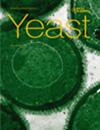利用 JC-D7 对酵母提取物中的多聚磷酸盐进行快速荧光测定
IF 2.6
4区 生物学
Q4 BIOCHEMISTRY & MOLECULAR BIOLOGY
引用次数: 0
摘要
聚磷酸盐(polyP)是一种有趣的分子,几乎存在于所有生物体内,具有多种细胞功能。在工业领域,聚磷酸酯因其独特的理化特性(包括 pH 缓冲、水结合和抑菌作用)而被广泛使用。尽管 polyP 十分重要,但对其进行分析仍然具有挑战性,目前的黄金标准是 31P NMR。在此,我们介绍一种使用荧光染料 JC-D7 的简单染色方法,用于对酵母提取物中的 polyP 进行半定量评估。值得注意的是,在 0.5-500 µg/mL 的 polyP 浓度范围内,荧光反应受 polyP 浓度和聚合物链长度的影响。因此,对于未知链组成的 polyP 样品,JC-D7 不能用于绝对定量。JC-D7 的荧光不受高达 50 mM 的无机磷酸盐的影响。微量元素(FeSO4 > CuSO4 > CoCl2 > ZnSO4)和有毒矿物盐(PbNO3 和 HgCl2)会减弱多聚物诱导的 JC-D7 荧光,从而影响其对含有多聚物-金属复合物的样品的适用性。荧光受 pH 值和温度等其他参数的影响很小。经过验证后,这种简单的检测方法被用于阐明携带(多)磷酸盐平衡基因缺失的酵母菌株产生多聚磷酸盐的程度。结果表明,JC-D7 染色法为检测酵母提取物中的 polyP 以及其他微生物提取物中的 polyP 提供了一种可靠而灵敏的方法。该检测方法简便易行,可对微生物进行高通量筛选,以全面阐明并提高生物技术生产多聚磷酸盐的潜力,最终促进磷的可持续利用。本文章由计算机程序翻译,如有差异,请以英文原文为准。
Rapid Fluorescence Assay for Polyphosphate in Yeast Extracts Using JC‐D7
Polyphosphate (polyP) is an intriguing molecule that is found in almost any organism, covering a multitude of cellular functions. In industry, polyP is used due to its unique physiochemical properties, including pH buffering, water binding, and bacteriostatic activities. Despite the importance of polyP, its analytics is still challenging, with the gold standard being 31 P NMR. Here, we present a simple staining method using the fluorescent dye JC‐D7 for the semi‐quantitative polyP evaluation in yeast extracts. Notably, fluorescence response was affected by polyP concentration and polymer chain length in the 0.5–500 µg/mL polyP concentration range. Hence, for polyP samples of unknown chain compositions, JC‐D7 cannot be used for absolute quantification. Fluorescence of JC‐D7 was unaffected by inorganic phosphate up to 50 mM. Trace elements (FeSO4 > CuSO4 > CoCl2 > ZnSO4 ) and toxic mineral salts (PbNO3 and HgCl2 ) diminished polyP–induced JC‐D7 fluorescence, affecting its applicability to samples containing polyP–metal complexes. The fluorescence was only marginally affected by other parameters, such as pH and temperature. After validation, this simple assay was used to elucidate the degree of polyP production by yeast strains carrying gene deletions in (poly)phosphate homeostasis. The results suggest that staining with JC‐D7 provides a robust and sensitive method for detecting polyP in yeast extracts and likely in extracts of other microbes. The simplicity of the assay enables high‐throughput screening of microbes to fully elucidate and potentially enhance biotechnological polyP production, ultimately contributing to a sustainable phosphorus utilization.
求助全文
通过发布文献求助,成功后即可免费获取论文全文。
去求助
来源期刊

Yeast
生物-生化与分子生物学
CiteScore
5.30
自引率
3.80%
发文量
55
审稿时长
3 months
期刊介绍:
Yeast publishes original articles and reviews on the most significant developments of research with unicellular fungi, including innovative methods of broad applicability. It is essential reading for those wishing to keep up to date with this rapidly moving field of yeast biology.
Topics covered include: biochemistry and molecular biology; biodiversity and taxonomy; biotechnology; cell and developmental biology; ecology and evolution; genetics and genomics; metabolism and physiology; pathobiology; synthetic and systems biology; tools and resources
 求助内容:
求助内容: 应助结果提醒方式:
应助结果提醒方式:


